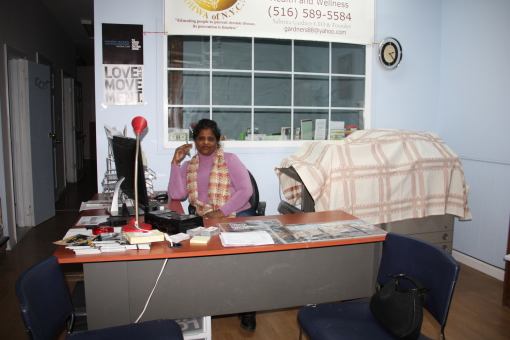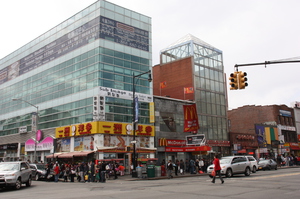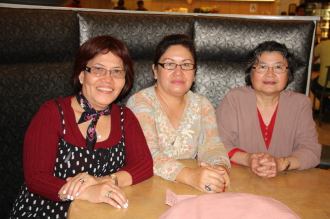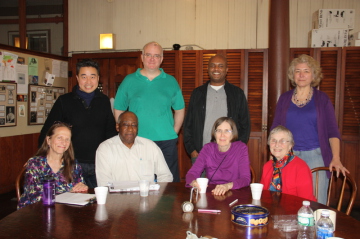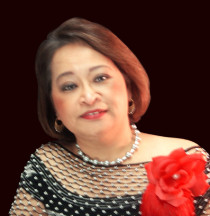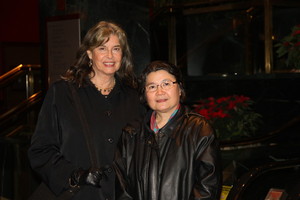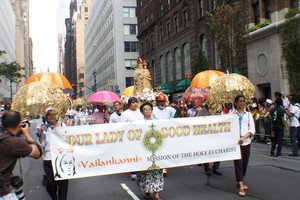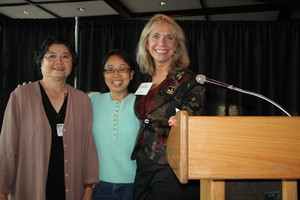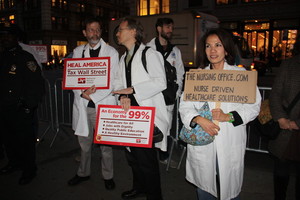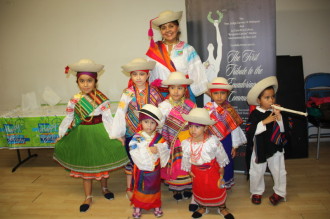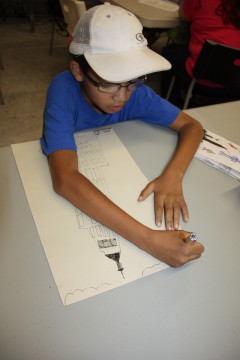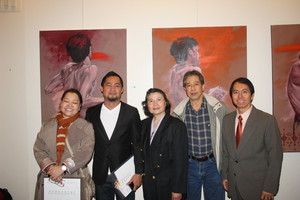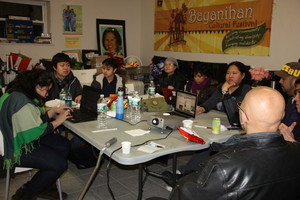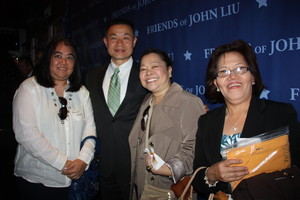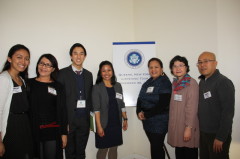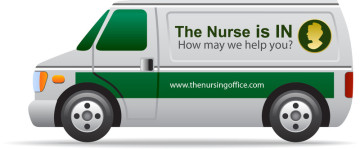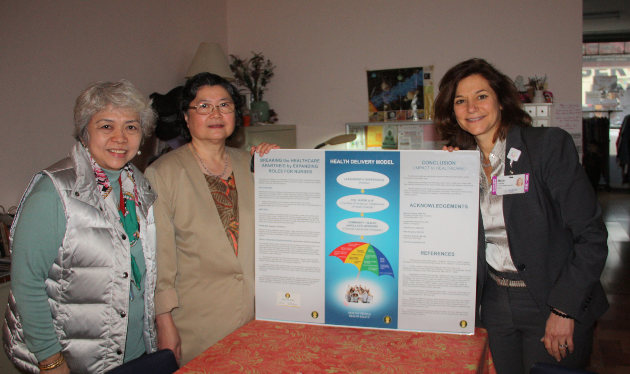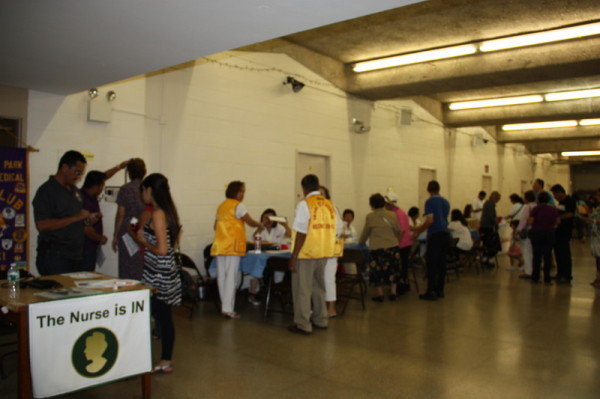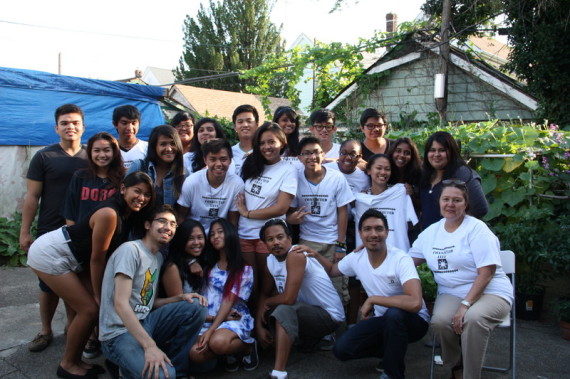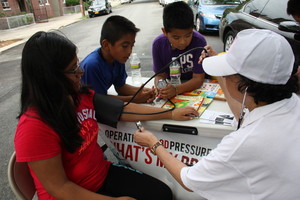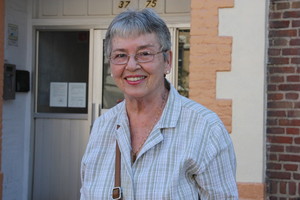“Any person coming into this Nursing Office should feel the touch of human kindness in many ways.” ~Myrna D. Santos, RN
TRANSFORMING HEALTHCARE THROUGH NURSING LEADERSHIP
The Nurse is IN: A Model for Affordable Community and Public Health
Delivery System
This presentation will show that a Community Health Survey in 1994-1998, entitled "Challenging the Heath Care Apartheid," has found that " recognizing ethno-cultural barriers is an important step in reforming and democratizing the healthcare system," and that "the irony (of widening disparity) becomes more glaring because the leading killers of people of color have been attributed to diseases that are largely preventable." The study used NYS DOH concepts of Access, Cultural Competency, and Quality of Care. The findings established factors critical to health outcomes: lack of health insurance, education level, and poverty; lack of culturally competent services; lack of ethnic minority health care providers; low utilization of care, health promotion, and disease prevention services.
The focal portion will show how The Nurse is IN program seeks to "break the health care apartheid" by expanding roles and functions of Nurses --- making them catalysts for change, thereby shaping the future of Nursing and health care.
Inspired by the Institute of Medicine (IOM) reports and recommendations from the Robert Wood Johnson Foundation, The Nursing Office developed a model of affordable health care delivery system, addressing issues of disparity and inequity, and countering ineffectiveness of the current system in the multi-cultural structures of our communities. The model also creates an environment of "transcultural nursing" articulated by the Leininger School in the 1970s, promoting culturally sensitive nursing care that bridges differences between cultural belief systems of caregiver and client.
This is a response of professional Nurses to transform the system and make it responsive to unmet needs of minorities, ethnic groups, and marginalized populations of rural and urban America and in the global community. It is a program with Evidence-based Nurse-driven Health care Solutions, consistent with goals of Healthy People 2020, which includes social issues of homelessness, poverty and unemployment. It includes natural holistic solutions based on socio-cultural and economic factors, to build Basic Community Living Infrastructures with individuals and families, that are collaborative, participative, culturally sensitive, and integrative within a Community Health Center, run by the community, for the community.
This model uses an affordable delivery approach, utilizing multiple roles of Nurses as trainers, educators, healers, innovators, leaders and engaging them as Communicators, Bridges, Facilitators, Connectors to reach invisible, voiceless, uninsured, high-risk persons with little or no access to culturally competent health care services. More pointedly, these Nurses will be Communicators in the linear model of delivery from legislative and executive sources to the public, through Community Healthcare Workers (CHWs) chosen from and trained to work with their own people.
It is a model easing nursing shortages by maximizing their roles in health care; create more jobs; reduce unemployment; and reduce health care costs through effective resource use. Delivery components are: Capacity-Building & Training, Health Education & Promotion, Advocacy & Political Action, Outreach & Network Development, Research, Sustainability, and Effective Communications. Strategies are: supporting Nurses' venues in physical offices, Internet-based websites, Referral sites, and Social Media sites; designing effective Health Fairs; enhancing Nurses' leadership skills; and utilizing Allied health and healthcare workers in forging community partnerships.
The Nurse is In: How May We Help You?
Organizational Model: Shared Mission, Shared Governance and Shared Resources
- The Nursing Office Acts as a consultant in the development of management and administrative policies for the Partner Organizations according to its Shared Mission, Shared Governance, and Shared Resources organizational model.
- Collaborates with the partner organization in developing programs and its delivery in the community.
- Share in the execution and implementation of all policies and decisions of the Board of the Partner Organization.
- Reports to the Board of Officers of the Partner Organization.
Taking Care of Communities
The Nursing Office is developing programs to extend its health and nursing services to the community. These services will be made available to communities serving the minorities, ethnic groups and marginalized population of both urban and rural America as well as the international community. It is a Community and Public Health Delivery System.
Features:
- Nurse-Driven Healthcare Solutions
- Nurse-Driven Housing Solutions
- Research & Evidence-based
- Affordable Community & Public Health Delivery
- Conservative, Practical Organizational Sustainability
- Individual, Family & Community Oriented
- Collaborative & Participative Approach
- Culturally Sensitive
- Integrative, Participative Community Centers
- Creative TEAMS Design
- Natural & Holistic
Programs & Services
Extended Arts Center: A Safe Haven for Creativity
The Nurse is In: How may we help you?
Pathway Home Transition Housing
Financial Services: Health is Wealth
Nursing Annex: Practical Lifelong Learning
Advocacies
- Rico Adelan Foundation VIP Voice of the Invalid Person
- Catherine D. Suba Rehabilitation Solutions
Healthcare Delivery Components
- Capacity Building &Training
- Health Education & Promotion
- Advocacy & Political Action
- Outreach & Network Development
- Research
- Sustainability
- Communications
In Memoriam: Raquel Z. Ordonez, MPA
A Salute to a Champion of Equity and Equality in Quality Healthcare Among People of Color
Disparity in Community and Public Health Delivery
The Nursing Office initiatives against Disparity and Inequity in a highly cultural melting pot of immigrants as New York City, is based on the book “Challenging the Health Care Apartheid: Equality and Equity for People of Color, (A Report on The Community Health Survey 1994-1998. Raquel Z. Ordonez, MPA, Principal Investigator).The study, conducted under the auspices of The Coalition for the Advancement of Filipino Women, was supported by the NYS Department of Health, Office of Minority Health, and the U.S DHHS - Region II Office of Minority Health.
This system of delivery will involve a pool of human services network of grassroots organizations and all individuals from all walks of life committed to improving the status of women and their families and communities through:
- Family, spiritual, economic and political empowerment
- Youth support and leadership development
- Citizenship education
- Equity, equality in quality healthcare
The Nursing Office (TNO) strives for fair and just treatment of all categories of people by creating opportunities and mechanisms to translate community resources and capacities into purposeful and meaningful actions. TNO shares with the Coalition for the Advancement of Filipino Women (CAFW) and the women and nurses of the world, a commitment to action to realize the common vision of a global community where equality, equity, justice development and peace reign.
“If New York is to continue as a desirable place to live and raise families in the 21st century, if New York is to enhance its competitiveness in national and international markets, if New York is to retain its international stature in business, education, the arts, research and development, and in short, if New York is to ensure the steady creation of opportunities for its citizens , all new Yorkers must be as healthy, as our knowledge, technology and commitment permit.”
~ New York State Public Health Council
Communities Working Together for a Healthier New York
COMMUNITY NEWS in PICTURES
Community: Watch & Listen
AFFORDABLE COMMUNITY and PUBLIC HEALTH DELIVERY
- Finding Venues to Reach Out
- Public Health Education
- Health Fairs: A Good Start
- Designing Health Fairs that Work
- Community Partnerships
- Political Action
- Finding Resources
- Effective Use of Resources
- Pointing Out the Target Communities
- Empowering Nurses and Leadership
- Utilizing Community and Allied Health Healthcare Workers
- Empowering Communities
HEALTHY PEOPLE 2030
We at The Nursing Office, do not intend to "re-invent" the wheel or design new programs, but rather work and collaborate with the government and major organizations to implement programs so that they become effective and responsive to the target people and communities. These institutions have already designed these programs with due diligence, therefore they are ready to be implemented.
CURRENT PUBLIC AND COMMUNITY HEALTH ISSUES
- Disparity & Inequity (Healthcare Apartheid) Debunking the Reality
- Homelessness (Acting On)
- Silent Corruption in HealthCare (Learning the System)
- Politics in Healthcare (Weighing Pro's and Con's)
The Nurse is IN:
A Model for Affordable Community and Public Health
Delivery System
Principal:
Myrna D. Santos, MSN, RN
Chief Nurse Executive
The Nursing Office
198-26 Jamaica Avenue, Hollis, NY 11423
(718) 687 - 2581
Email: myrnyc@msn.com; myrsan@thenursingoffice.com
Program Director:
Lutgarda M. Resurreccion, BA
Collaborators:
Ayal B. Lindeman, EMT, LPN
Yolanda Nurse, MSA, RN
Nilda Berguido, BSN, RN
Information Technology:
Carmel B. Sanchez, MS, RN
REFERENCES
1. "APICHA Community Health Center - Investing in Our Future," APICHA News, A publication of APICHA Community Health Center, Vol. 17, Number 1 Summer/Fall 2012.
2. "A Call to Support Health System Reforms in 624 Poor Areas in the Philippines," Forum on Public Health in the Philippines: Progress and Challenges, November 13, 2013, Philippine Center, 556 Fifth Avenue, New York, NY 10036.
3. Challenging the Health Care Apartheid : Equality and Equity for People of Color, A Report on The Community Health Survey 1994-1998. Raquel Z. Ordonez, MPA, Principal Investigator The study, conducted under the auspices of The Coalition for the Advancement of Filipino Women, was supported by the NYS Department of Health, Office of Minority Health, and the U.S DHHS - Region II Office of Minority Health. It does not reflect their views and opinions. Published by Entre-Mundos, Copyright@1998 Coalition for the Advancement of Filipino Women, New York.
4."Flushing's Economy: Challenges & Opportunities," Community Profile, May 2013, One Flushing: Community Economic Development Center. A Report published by Asian Americans for Equality, Inc., New York City.
5. Healing the Health Care System: Asian American Voices for Health Care Reform. Project CHARGE (Coalition for Health Access to Reach Greater Equity) April 2010, New York City. Project CHARGE (Coalition for Health Access to Reach Greater Equity) is a health collaborative of 15 partner organizations that have come together to address health access for Asian Americans in NYC.)
6. KALUSUGAN Community Services 20th and Filipino-American Wellness Center 10th Anniversary Celebration, November 16, 2012, Joe & Vi Jacobs Center, 404 Euclid Avenue, San Diego, CA 92114.
Lobby Training for Single Payer Health Care
WHEN: Sunday, April 12, 2015 11AM — 3PM
WHERE: 131 W 33rd Street, 4th Floor, New York NY 10001
Join single-payer supporters as we learn to answer tough questions on the Gottfried/Perkins New York Health Act (A.5062/S.3525) in meetings with your legislators. Get the latest information on how we'll fund single payer in New York State and practice lobbying scenarios so you're ready for Statewide Single Payer Lobby Day on Tuesday, May 5th in Albany.
This session will prepare you to advocate for a health care system that puts people over profit. The bill was reintroduced this session with enough cosponsors to pass the Assembly. Let's push to pass single-payer in New York State this session and say loud and clear, Health Care IS A Human Right!
Understanding DSRIP: Community Engagement Will Be Key to its Success
WHAT IS DSRIP?
The Delivery System Reform Incentive Payment (DSRIP) Program is a five-year Medicaid funding program established between New York State and the federal Center for Medicare and Medicaid Services (CMS). The overall goal of DSRIP is to reduce avoidable hospitalizations by 25% by offering funding to transform the health system for Medicaid members and the uninsured. Medicaid members often use hospitals because accessible, affordable and culturally competent care is not available in their community.
WHAT IS A PPS?
Performing Provider Systems (PPS), are coalitions of hospitals and other health care providers that are to work together to improve services. PPSs are responsible for implementing DSRIP projects in the state by integrating health and mental health services and expanding care in the community. The PPS will only be paid by meeting the predefined results in system transformation, clinical management of patients, and improving population health.
WHY SHOULD WE CARE ABOUT DSRIP?
Most of us understand and agree that the medical/health care system does NOT work well for us. This is particularly true for low-income people, immigrants, people of color, people with disabilities, and the uninsured. The system is very costly, but the funding is often not directed where it is most needed. The goal of DSRIP is to change this situation, but this will only happen if we work together to ensure the outcome.
The $7.3 billion cost of DSRIP over five years should be enough money to make a difference and improve the system for people. Right now, how this funding is spent could be limited to a handful of big hospitals, often acting as the lead in the PPSs. If this happens, there will not be the change that is needed to improve the health of people who need care.
In order for DSRIP to be successful, the decision-making process must be open and include community-based organizations, community residents and representatives. In order for DSRIP to be most successful, that it is not just medical care that will make the difference, rather what is needed is an expansion of health care to include other factors that impact the wellbeing of communities (including housing, food, supportive services, and more). These are called the social determinants of health.
Community-based providers and community organizations are seen as the trusted brokers in many communities and they are the ones who are able to reach and engage hard to reach communities. Contracting with these groups will enable them to provide these contacts. This is the only way that the goals of DSRIP will be met.
RESOURCES
For more information on DSRIP, please go to the NYSDOH DSRIP website at https://www.health.ny.gov/health_care/medicaid/redesign/dsrip/
For more information on Brooklyn health statistics, please go to the NYCDOHMH website at http://www.nyc.gov/html/doh/html/data/nyc-health-profiles.shtml
GET ENGAGED! JOIN OUR ADVOCACY EFFORTS!
For how to be involved in the collective efforts of community-based organization to ensure their engagement in DSRIP, please send email to centralbkhealth@gmail.com or call Commission on the Public’s Health System at 646-325-5317





